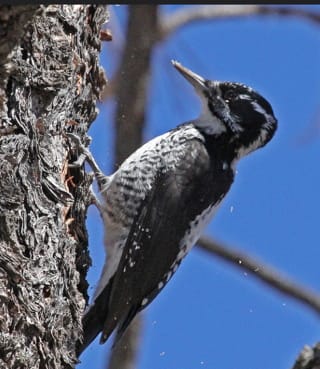Initially this guide displays common birds of all types that are flying right now in our area. Use the selectors below to view rare birds, view birds flying any time, restrict the output to a certain shape of bird, or search by name.
New Mexico is on the western edge of the Central Flyway which is one of the major migration pathways between north and south for birds traveling between breeding and wintering grounds along the Rocky Mountains. This has resulted in the state having an incredible diversity of birds with over 550 different species reported. A little more than half of this number are sighted annually on the Pajarito Plateau. Some of these birds are full-time residents, some migrate here for a few weeks or months, and other are only seen briefly as they pass through the region.
This guide features many of the birds known to frequent Los Alamos county by when they are likely to be seen in the area. You can get additional information on local birds by joining PEEC Birders or going to the eBird website. eBird also includes lists of rare bird sightings and birding hot spots.
Bird References
Birdweb
Cornell Lab of Ornithology
eBird
eNature
Institute for Bird Populations
National Audubon Society
New Mexico Ornithology Society
What Bird
xeno-canto
Subject Area Experts (all guides)
Steve Cary (butterflies)
Beth Cortright (insects)
Terry Foxx (invasive plants)
Leslie Hansen (mammals)
Richard Hansen (fish, mammals)
Dorothy Hoard (butterflies, trees)
Chick Keller (flowers, herbarium)
Shari Kelley (geology)
Kirt Kempter (geology)
Garth Tietjen (reptiles)
David Yeamans (birds)
Web Development and Content Management
Pat Bacha
Jennifer Macke
Graham Mark
Akkana Peck
Contact
Please contact us for local nature questions and sightings. We welcome comments, corrections, and additions to our guides.
For more information about local nature, please visit our Nature Blog or subscribe to PEEC This Week.
Make Selection
 Photo: male by David Mitchell  Photo: female by Jerry Oldenettel |  American Three-toed WoodpeckerATTW (Picoides dorsalis)Family: Picidae (Woodpeckers) Size: 8.5 in (22 cm) Flies: Mar 15 - Oct 07 Morphology: mostly black body with a white throat, breast, and belly; a black head with a white line running towards the beak and behind the eye; three toes (two pointing forward and one back); males have a yellow cap Status: native; uncommon Food source: mostly eats insects including wood-boring beetle larvae and caterpillars; will also eat fruit and sap Habitat: coniferous forests The American Three-toed Woodpecker is often overlooked as it quiet and inconspicuous. It often perches motionlessly against a tree trunk for an extended period of time. These woodpeckers forage on conifers, in particular dead or dying trees. They will remove pieces of bark to find insects and may gradually remove all the bark from a dead tree. Nests consist of a cavity in a tree or something like a utility pole. Both sexes excavate a new cavity each year. Eggs are incubated for 12 to 14 days. The young leave the nest 3 to 4 weeks after hatching but may remain with the parents for another 4 to 8 weeks. Info Photos Distribution Frequency |
